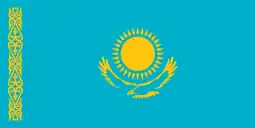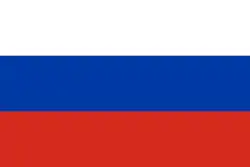Flag of Kazakhstan
The flag of Kazakhstan or Kazakh flag (Kazakh: Қазақстан туы, Qazaqstan tuy; Russian: Флаг Казахстана, romanized: Flag Kazakhstana) was adopted on 4 June 1992, replacing the flag of the Kazakh Soviet Socialist Republic. The flag was designed by Shaken Niyazbekov.
 | |
| Name | Қазақстан Республикасының мемлекеттік туы Qazaqstan Respublikasynyñ memlekettık tuy Флаг Республики Казахстан Flag Respubliki Kazakhstan |
|---|---|
| Use | National flag and civil ensign |
| Proportion | 1:2 |
| Adopted | 4 June 1992 |
| Design | A gold sun with 32 rays above a soaring golden steppe eagle, both centered on a cyan field. The hoist side displays a national ornamental pattern "koshkar-muiz" |
| Designed by | Shaken Niyazbekov |
 Variant flag of Republic of Kazakhstan | |
| Use | Naval ensign |
| Proportion | 1:2 |
| Design | The eagle and sun from the national flag, both centered on a bicolour of white and cyan. In the canton is a blue anchor with a red star over it. |

Description
The national flag of the Republic of Kazakhstan has a gold sun with 32 rays above a soaring golden steppe eagle, both centered on a sky blue background; the hoist side displays a national ornamental pattern called "koshkar-muiz" (the horns of the ram) in gold; the blue colour is of religious significance to the Turkic peoples of the country, and so symbolises cultural and ethnic unity; it also represents the endless sky as well as water; the sun, a source of life and energy, exemplifies wealth and plenitude; the sun's rays are shaped like grain, which is the basis of abundance and prosperity; the eagle has appeared on the flags of Kazakh tribes for centuries and represents freedom, power, and the flight to the future. The width of the flag to its length is 1:2.[1]
Colours scheme |
Sky Blue | Golden |
|---|---|---|
| Pantone | 3125 U | 102 U |
| CMYK | 100-13-0-20 | 0-22-94-0 |
| HEX | #00AFCA | #FEC604 |
| RGB | 0-175-202 | 254-197-12 |
Symbolism

The gold and blue colours were inherited from the former Soviet flag which were the gold from the hammer and sickle and the cyan bar from the bottom of the flag. The pattern represents the art and cultural traditions of the old Khanate and the Kazakh people. The sky blue background symbolises the peace, freedom, cultural, and ethnic unity of Kazakh people including the various Turkic people that make up the present-day population such as the Kazakhs, Tatars, Uyghurs, Uzbeks, as well as the significant Indo-European peoples. The sun represents a source of life and energy. It is also a symbol of wealth and abundance; the sun's rays are a symbol of the steppe's grain which is the basis of abundance and prosperity.
People of different Kazakh tribes had the golden eagle on their flags for centuries. The eagle symbolises the power of the state. For the modern nation of Kazakhstan the eagle is a symbol of independence, freedom and flight to the future.[2]
Historical flags
 Alleged flag of the Kazakh Khanate
Alleged flag of the Kazakh Khanate Flag of the Russian Empire and the Russian Republic until 1918
Flag of the Russian Empire and the Russian Republic until 1918 Flag of Amangeldy Imanov's associates who rebelled in 1916
Flag of Amangeldy Imanov's associates who rebelled in 1916 Alash Autonomy from 1917 to 1920
Alash Autonomy from 1917 to 1920 Second version
Second version Flag of the Alash Autonomy which is mentioned in 1918
Flag of the Alash Autonomy which is mentioned in 1918.svg.png.webp)
.svg.png.webp) Flag of the Kazakh Soviet Socialist Republic from 1937 to 1940
Flag of the Kazakh Soviet Socialist Republic from 1937 to 1940.svg.png.webp) Flag of the Kazakh Soviet Socialist Republic from 1940 to 1953
Flag of the Kazakh Soviet Socialist Republic from 1940 to 1953 Flag of the Kazakh Soviet Socialist Republic from 1953 to 1991
Flag of the Kazakh Soviet Socialist Republic from 1953 to 1991
Variants
.svg.png.webp) Early design of the flag of the Republic of Kazakhstan before June 4, 1992.[5]
Early design of the flag of the Republic of Kazakhstan before June 4, 1992.[5] Flag for the Kazakh armed forces, featuring a red star
Flag for the Kazakh armed forces, featuring a red star Presidential standard, featuring the national emblem
Presidential standard, featuring the national emblem
Gallery
 Alexander Vinokurov during the Men's cycling event at the 2012 Summer Olympics in London donning the Kazakh flags on rims.
Alexander Vinokurov during the Men's cycling event at the 2012 Summer Olympics in London donning the Kazakh flags on rims. The Kazakh flag at Embassy of Kazakhstan in Moscow.
The Kazakh flag at Embassy of Kazakhstan in Moscow. T-72 tank in the national colours.
T-72 tank in the national colours. A crowd with the flag of Kazakhstan.
A crowd with the flag of Kazakhstan. A flag of Kazakhstan flying.
A flag of Kazakhstan flying. Spectators with the Kazakh flag.
Spectators with the Kazakh flag. The flag of Kazakhstan hanging at the Swedish Embassy in Stockholm.
The flag of Kazakhstan hanging at the Swedish Embassy in Stockholm. Kazakh contingent during the 2015 Moscow Victory Day Parade with the national flag.
Kazakh contingent during the 2015 Moscow Victory Day Parade with the national flag. The national flag hanging vertically.
The national flag hanging vertically.
References
- CIA – The World Fact Book Archived 9 August 2010 at the Wayback Machine
- Kazakhstan national flag
- Kazakhstan in the Soviet Union (early flags)
- Флаги Советского Казахстана
- "государственный флаг Казахстана". www.vexillographia.ru. Retrieved 9 October 2018.
External links
| Wikimedia Commons has media related to National flag of Kazakhstan. |

